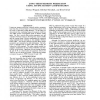Free Online Productivity Tools
i2Speak
i2Symbol
i2OCR
iTex2Img
iWeb2Print
iWeb2Shot
i2Type
iPdf2Split
iPdf2Merge
i2Bopomofo
i2Arabic
i2Style
i2Image
i2PDF
iLatex2Rtf
Sci2ools
115
Voted
ICIP
1999
IEEE
1999
IEEE
Long-Term Memory Prediction Using Affine Motion Compensation
Long-term memory prediction extends motion compensation from the previous frame to several past frames with the result of increased coding efficiency. In this paper we demonstrate that combining long-term memory prediction with affine motion compensation leads to further coding gains. For that, various affine motion parameter sets are estimated between frames in the long-term memory buffer and the current frame. Motion compensation is conducted using standard block matching in the multiple reference frame buffer. The picture reference and the affine motion parameters are transmitted as side information. The technique is embedded into a hybrid video coder mainly following the H.263 standard. The coder control employs Lagrangian optimization for the motion estimation and macroblock mode decision. Significant bit-rate savings between 20 and 50 % are achieved for the sequences tested over TMN-10, the test model of H.263+. These bit-rate savings correspond to gains in PSNR between 0.8 and ...
Affine Motion Compensation | Affine Motion Parameter | Affine Motion Parameters | ICIP 1999 | Image Processing |
Related Content
| Added | 25 Oct 2009 |
| Updated | 25 Oct 2009 |
| Type | Conference |
| Year | 1999 |
| Where | ICIP |
| Authors | Thomas Wiegand, Eckehard G. Steinbach, Bernd Girod |
Comments (0)

